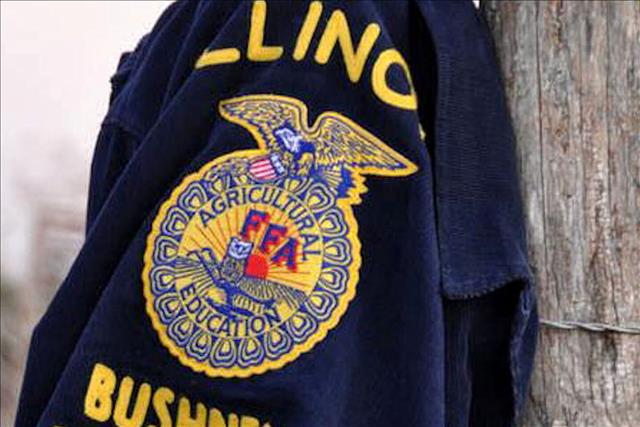
Chatter about ag education funding was rampant across the internet and in real life the past few days, crossing state lines even to find support. Really, my Facebook feed this week has been maybe 40% Trump and 60% Illinois Ag Ed. Generally, I’d call any day that has less Trump and more agriculture a good one, but there was a vein of misinformation that kept popping up.
Frankly, education is confusing in Illinois, much less ag education funding – which operates with a special group and a budget line item. So with that in mind, here are 10 things you need to know about ag education funding in Illinois:
1. The Governor isn’t cutting the entire Illinois ag education program. In his budget proposal for FY17, Governor Rauner has zeroed out the Agriculture Education Line Item (more on that later). Individual school districts still decide whether they’ll have an ag education program, based on their own priorities and budgets. Not the Governor.
2. Ag education is growing in Illinois. Illinois is home to 321 high school agriculture programs, 30 of which are new in the past 5 years. Total student enrollment is up by more than 5,000 students since 1999/2000; more than 29,000 Illinois students take ag classes and more than 17,000 of them are FFA members. Growth is good.
3. The Agriculture Education Line Item provides additional funding. The line item began in 1987 as a $48,000 allotment. It kicked up to $1 million in 1989, and was used to create the Facilitating Coordination in Agricultural Education (FCAE) program, at a time when student enrollment was under 12,000. Today, the line item is at $1.8 million and more than 29,000 kids are taking ag classes (see #2).
4. The $1.8 million goes to schools, grants, FCAE. 35% of those dollars go to high school ag programs as incentive funding; 321 programs average $1,800 each. Ag programs can use those dollars to buy microscopes, welders, power tools, iPads, greenhouses and more. Another 6% of the funding is also used to provide grants to seven Illinois colleges to recruit and train ag teachers. The majority – 59% - of the $1.8 million funds FCAE (keep reading).
5. FCAE supports ag teachers. What does that even mean? FCAE provides five regional staff, plus a state coordinator. Those support people offer on-site assistance for the 380-plus ag teachers in Illinois, and for Ag in the Classroom coordinators and community college ag instructors. They also develop curriculum and teaching resources, offer professional development, and award grants for programs, facilities and to support county Agriculture in the Classroom partnerships. If you want to break down the 59% ($1,039,900) that funds FCAE, it looks like this: $580,000 to teacher and program services; $309,000 to curriculum and in-service; $147,500 to administrative costs.
6. FCAE is unique. A few other states provide regional ag ed staff, including Missouri, California and Georgia. You don’t necessarily hear of a group facilitating education opportunities for, say, junior high math teachers. That’s akin to what FCAE does. It’s an extra in Illinois – but a really well-run, well-utilized, and incredibly vital extra. Because here’s the thing: a lot of schools use the line item’s incentive funding grant as their only funding source, beyond teacher salary. My ag teacher friends say there’s no doubt if the Ag Ed Line Item is actually zeroed out, you’ll see 20% fewer ag programs in the state within 3 to 5 years. Gulp.
7. FCAE is effective. You can make a solid case that hundreds of thousands of students have been impacted by these dollars annually, and they generate further dollars in matching grants and in-kind funds. FCAE puts that dollar figure at $11 million, counting earnings from students completing Supervised Ag Experience projects. Plus, ag teachers are perennially over-worked and under-paid, and FCAE helps them. Ag teacher friends add that FCAE’s work in young teacher retention is the only thing keeping the ag teacher shortage from becoming exponentially worse.
8. Line items get zeroed out. Illinois ag has been down this road before. Basically, there are several dozen line items in the budget. When the governor is trying to whittle down funds, he’ll zero out all the line items. The groups with the greatest outcry of support get theirs re-instated. Therefore, it’s good for ag ed to make a lot of noise about their funding. Thus the press releases, stories and blogs. And #SaveILAgEd.
9. The Ag Ed Line Item is part of the Illinois State Board of Education budget, not the IDOA budget. I don’t know whether this matters in the grand scheme of things, but I found it noteworthy. Additionally, funding for the Ag Ed Line Item last year was included in a K-12 education appropriations bill – one of the very few budget bills signed by the Governor, in June 2015. That’s how it got through in FY16. And there you go.
10. You can help. Contact your legislator. Contact the education appropriations committee. Contact the Governor. And support your local agriculture program! They always need judges, helpers, volunteers and people willing to make the case to the local school board about why agriculture matters. Be that person. Ranting about the governor on Facebook feels good, but it’s a lot less effective than true grassroots effort.
About the Author(s)
You May Also Like




